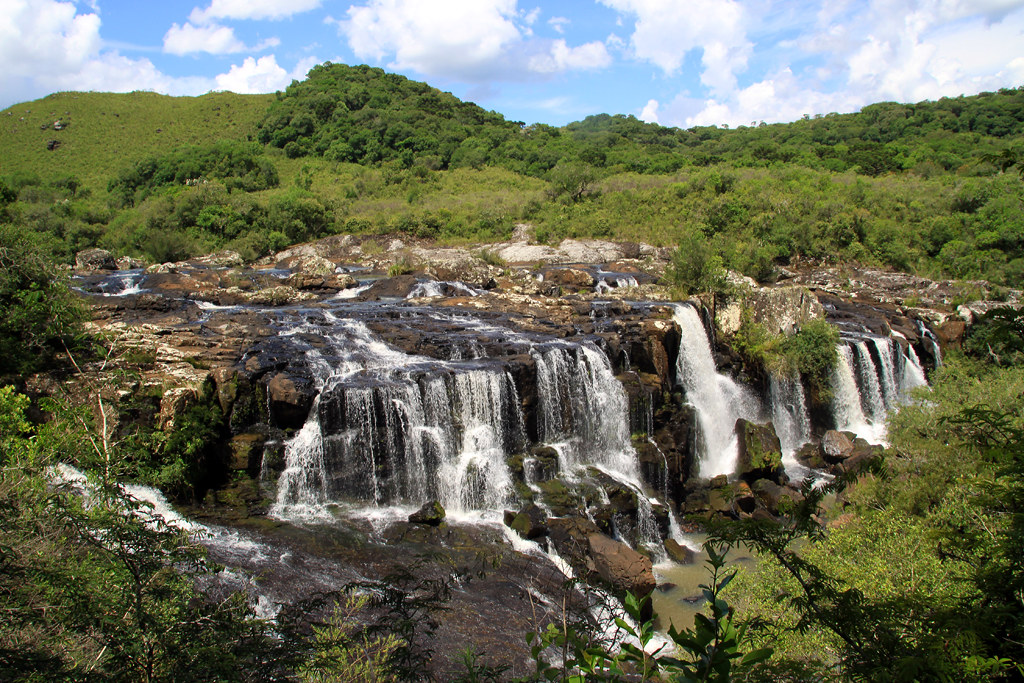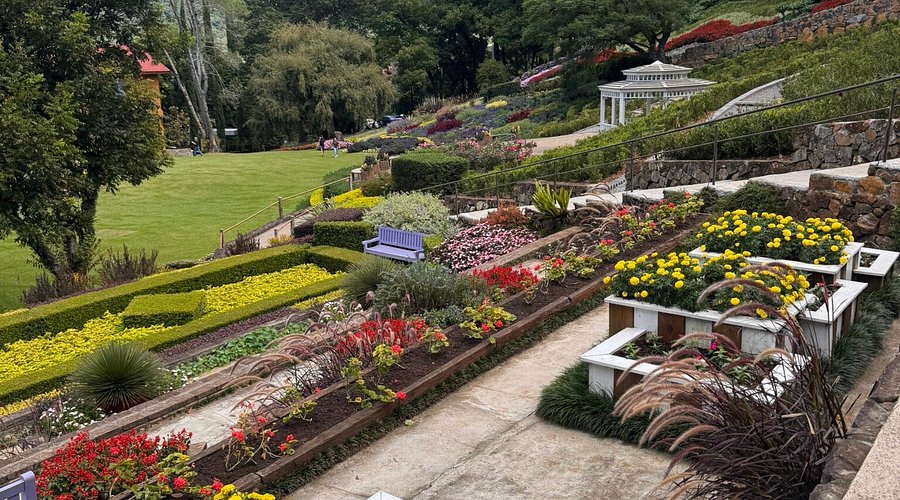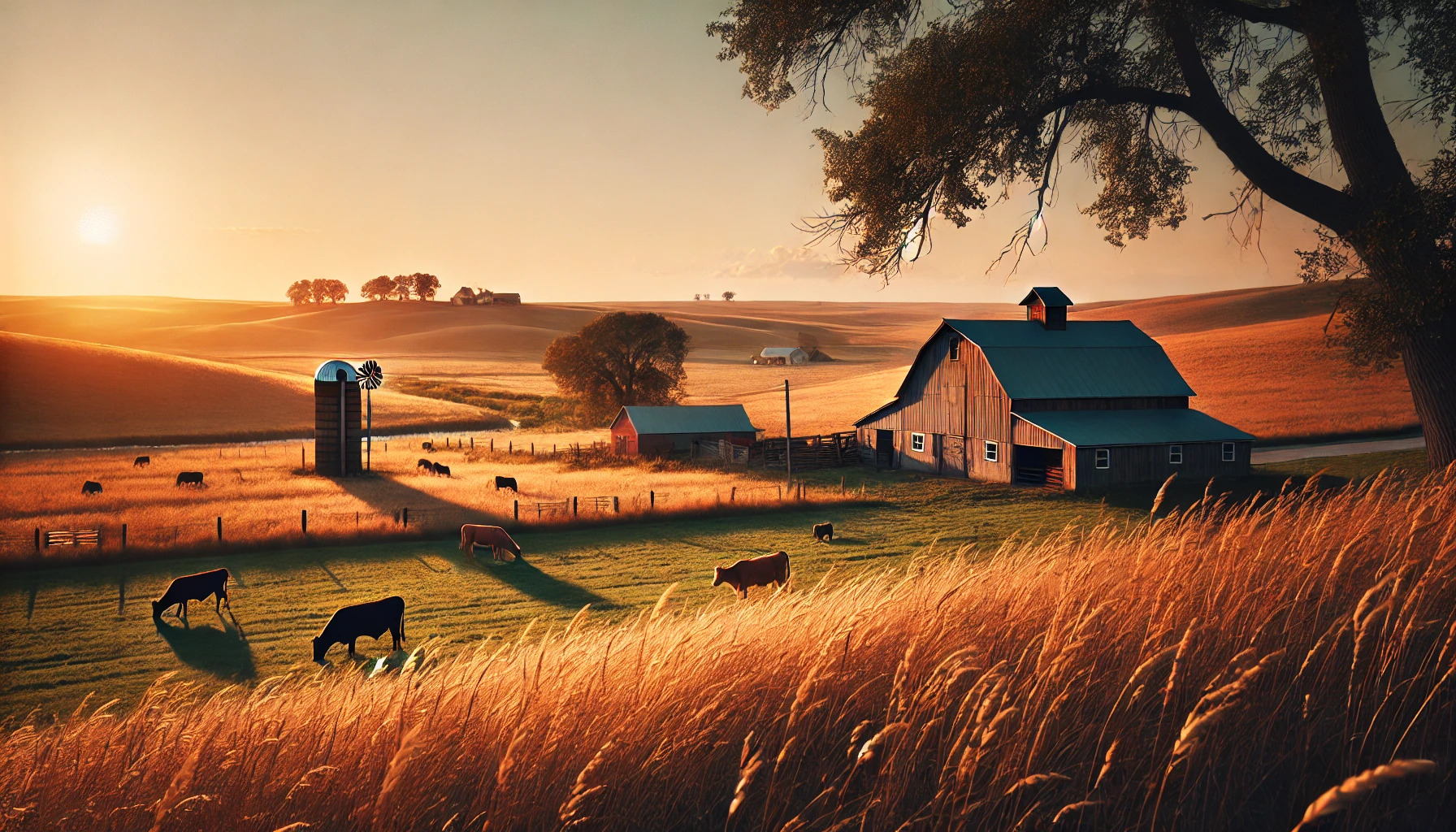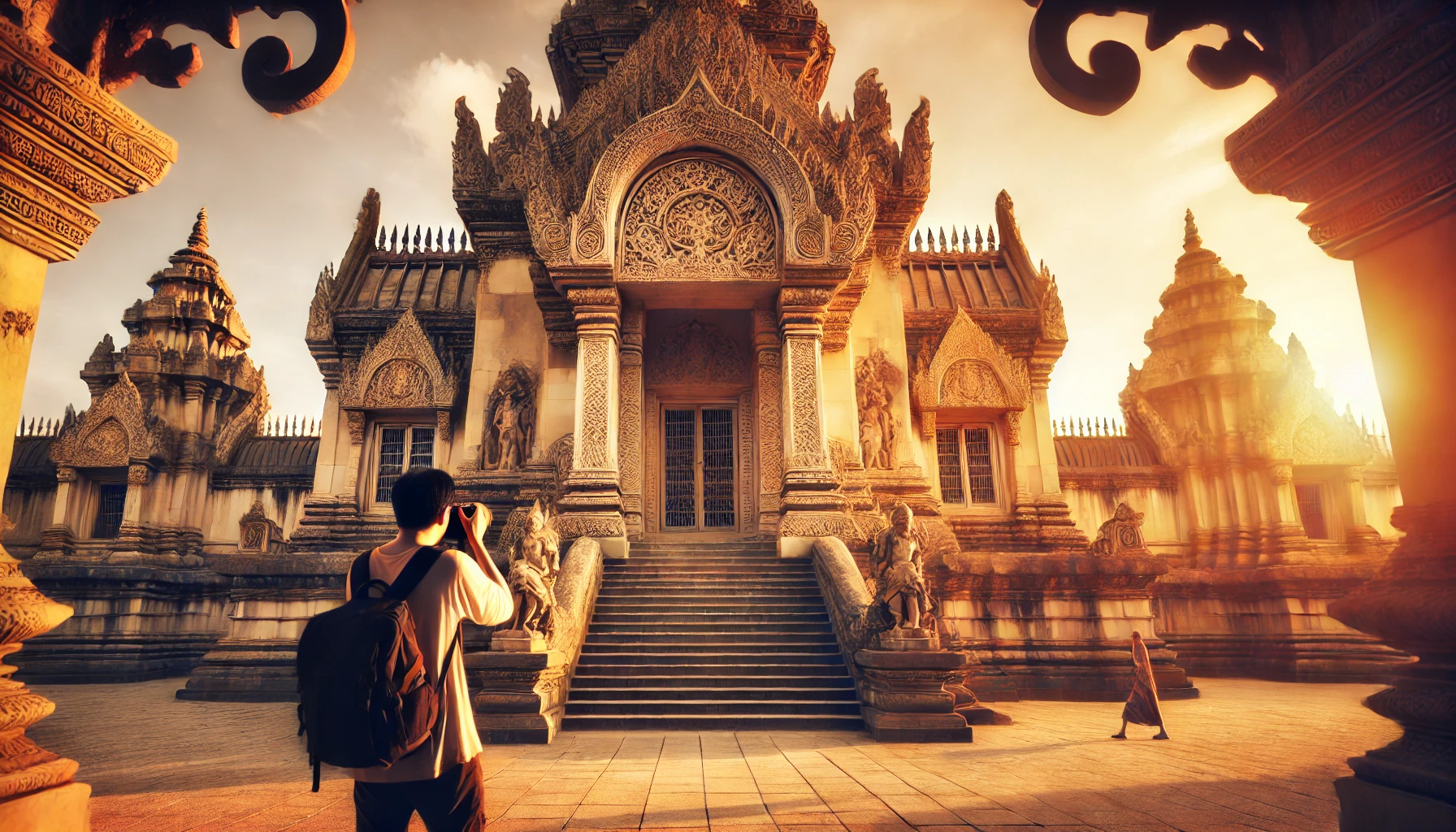Gramado, located in Serra Gaúcha, is a city known for its European charm, mild climate, and enchanting tourist attractions. Among these highlights is the Le Jardin Lavender Park, a space dedicated to the cultivation of lavender and the appreciation of nature in its most beautiful and harmonious form.
History and Concept
Opened in 2006, Le Jardin was born from the dream of creating an environment where visitors could enjoy the serenity provided by lavender. Unlike many conventional plantations, the park does not focus solely on French lavender but also cultivates varieties adapted to the region’s climate, offering a spectacle of colors and aromas throughout the year.
What to Find in the Park
Le Jardin offers much more than just flower fields. The space features themed gardens, greenhouses with ornamental plants, and an exclusive store selling lavender-based products such as cosmetics, essences, and decorative items. Additionally, there is a charming bistro, where visitors can enjoy teas and sweets inspired by the floral theme.
The gardens are designed to provide a unique sensory experience, with flower-lined paths, resting benches, and stunning views of the local vegetation. During the visit, it is possible to observe the cultivation process and learn more about the properties and benefits of lavender for well-being and health.
Sensory and Photographic Experience
One of the park’s main attractions is its relaxing atmosphere. The scent of lavender combined with the lush landscape creates an ideal environment for meditation, walks, and, of course, unforgettable photos. The scenery is perfect for romantic photo sessions, portraits, and special moments.
Useful Information
- Location: Rua Leopoldo Rosenfeld, 919 – Gramado, RS
- Opening Hours: Tuesday to Sunday, from 9:30 AM to 5:30 PM
- Admission: The park has free entry, but some areas and activities may have an additional cost
Conclusion
The Le Jardin Lavender Park is a true retreat for those seeking contact with nature, tranquility, and beauty. Whether for a romantic stroll, a sensory experience, or simply to appreciate the lush flora, this destination in Gramado is unmissable.
If you are planning a visit to the city, be sure to include this enchanting place in your itinerary!
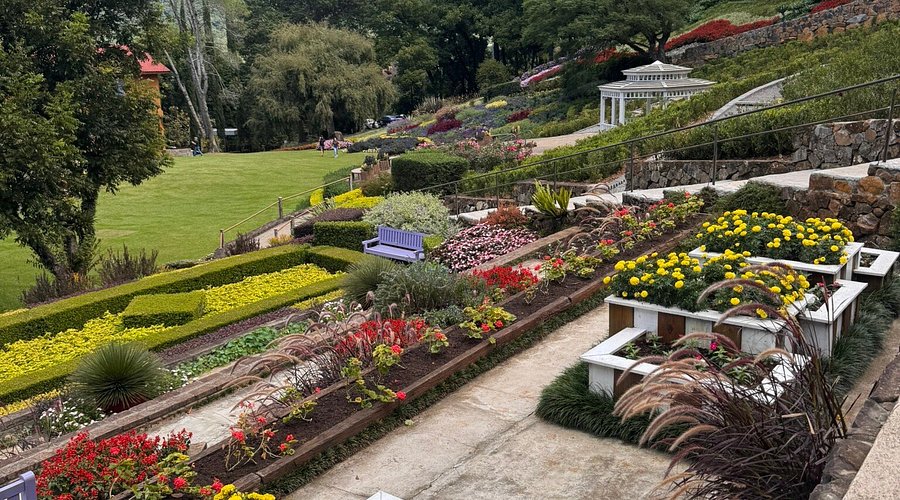
Black Lake: A Natural Treasure in the Heart of Gramado
Gramado is a city that enchants visitors with its European atmosphere and breathtaking landscapes. Among its most iconic natural attractions, Black Lake stands out as a true refuge of tranquility and beauty.
Origin and History
Black Lake was created in 1953 after a devastating fire in the region. To revitalize the area, an artificial lake was built, receiving tree seedlings imported from Germany’s Black Forest. This European influence contributed to the charm and unique identity of the location.
Things to Do at Black Lake
Black Lake is a perfect destination for those seeking contact with nature and moments of leisure. Among the activities available are:
- Pedal Boat Rides: One of the most traditional experiences, where visitors can navigate the lake and enjoy the landscape from a new perspective.
- Trails and Walks: The lake’s surroundings feature well-maintained trails, ideal for relaxing walks and observing local flora and fauna.
- Picnics: With grassy and shaded areas, it is an excellent place to bring a picnic basket and enjoy an outdoor moment.
- Photography: With such an enchanting setting, Black Lake is one of the most photographed spots in Gramado, perfect for capturing unforgettable moments.
Best Time to Visit
Black Lake is a destination that can be visited year-round, but each season provides a different experience:
- Spring and Summer: The vegetation is greener and in full bloom, making the environment vibrant and welcoming.
- Autumn: The reddish leaves create a romantic and charming landscape.
- Winter: Fog and cold weather add a magical touch, making it an excellent time for more introspective walks.
Useful Information
- Location: Rua A. J. Renner, Bairro Planalto – Gramado, RS
- Opening Hours: Open 24 hours
- Admission: Free entry, with charges only for pedal boat rides
Conclusion
Black Lake is one of Gramado’s most emblematic destinations, offering a perfect setting for relaxation and leisure. Whether for a romantic stroll, an outdoor walk, or simply to admire the landscape, this location is a must-see for anyone visiting the city.
Include Black Lake in your itinerary and discover why it is one of the most beloved places in Serra Gaúcha!
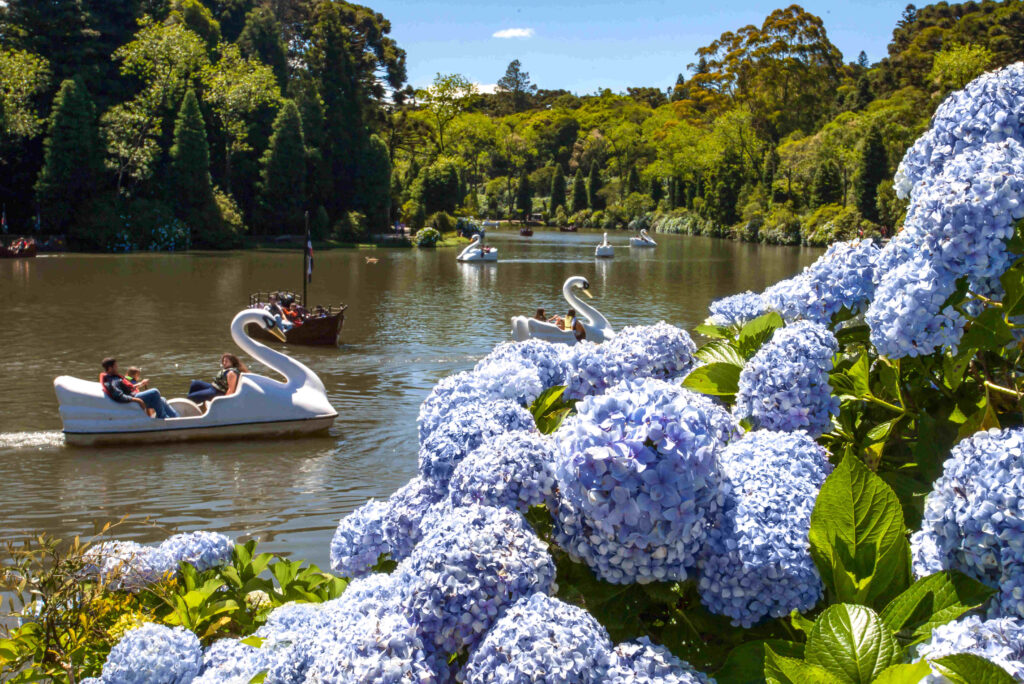
Ruins of the Canela Casino: A Historical and Mysterious Heritage of Serra Gaúcha
The city of Canela, located in Serra Gaúcha, is known for its natural beauty and charming tourist attractions. Among its historical points of interest, the Ruins of the Casino stand out as one of the most intriguing sites in the region. With a past shrouded in stories and mysteries, the site attracts curious visitors and culture enthusiasts who wish to learn more about this abandoned structure.
The History of the Casino
The ruins belong to the former Grande Hotel Canela, a luxurious establishment inaugurated in the 1910s. The hotel was built to cater to the elite of the time, offering sophisticated services and, as its main attraction, a casino where guests could enjoy games and entertainment.
However, with the prohibition of gambling in Brazil in 1946, the casino lost its main draw. Over the years, the hotel declined until it was abandoned. What remains today is the partially destroyed structure, which now forms the Ruins of the Casino.
What to Find at the Ruins
The ruins offer a glimpse into the luxurious past of the region. Among the remnants of the building, it is still possible to observe stone walls, parts of the original architecture, and details that recall the site’s glorious decades.
The mysterious and nostalgic atmosphere makes the ruins a popular setting for photographers, filmmakers, and tourists looking for a unique and historic environment. Additionally, it is an excellent place for reflection and connection with the region’s history.
Tourism and Access
Currently, the ruins do not have an organized tourist structure but can be visited by those who want to learn more about the city’s history. Visitors are advised to exercise caution when exploring the site, as the structure is deteriorated and lacks proper safety measures.
Conclusion
The Ruins of the Canela Casino are a historical landmark that recalls the glamorous eras of Serra Gaúcha. For those who appreciate places full of history and a touch of mystery, this is an interesting stop in Canela.
If you are planning a visit to the city, be sure to include this curious and enigmatic attraction in your itinerary!
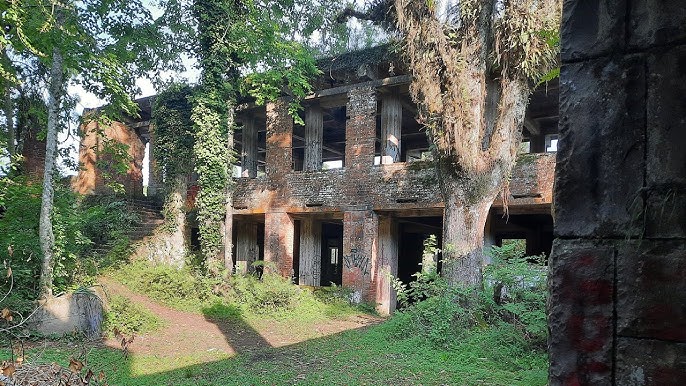
Salvati Winery: Tradition and Quality in the Heart of Serra Gaúcha
Bento Gonçalves is one of the most renowned wine tourism destinations in Brazil, home to wineries that preserve the Italian tradition of winemaking. Among them, Salvati & Sirena Winery stands out for the quality of its products and the authentic experience it offers visitors.
History and Tradition
Salvati Winery has its roots in the strong influence of Italian immigrants who colonized the region. Since its founding, the company has sought to combine traditional techniques with innovations in viticulture, resulting in wines and sparkling wines that reflect the essence of the Serra Gaúcha terroir.
The Winery Experience
Visitors to Salvati Winery can immerse themselves in the world of wine through activities that include:
- Guided tastings: One of the highlights of the visit, where guests can sample different labels and learn about their characteristics.
- Tour of the facilities: An opportunity to discover the winemaking process, from grape harvesting to aging in barrels.
- Wine and regional product shop: The perfect place to purchase exclusive wines and artisanal products from the region.
Highlight Wines
Salvati produces a variety of wines that cater to different palates. Some of the most appreciated include:
- Full-bodied reds, such as Merlot and Cabernet Sauvignon.
- Refreshing whites, like Chardonnay and Moscato.
- Refined sparkling wines, ideal for special celebrations.
Useful Information
- Location: Estrada do Vinho, Bento Gonçalves, RS
- Opening hours: Check in advance, as they may vary depending on the season.
- Tickets: Some experiences may require booking or an additional fee.
Conclusion
The Salvati & Sirena Winery is a must-visit destination for wine lovers and Italian culture enthusiasts. With a welcoming atmosphere and high-quality products, the winery offers an authentic experience that celebrates the winemaking tradition of Serra Gaúcha.
If you’re planning a visit to Bento Gonçalves, be sure to explore this charming haven for fine wine enthusiasts!
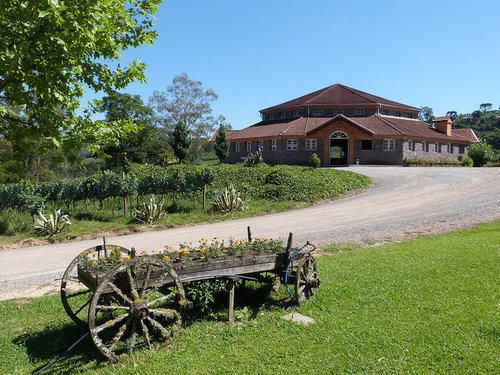
Stone Paths: A Journey Through the History and Culture of Bento Gonçalves
If you’re a fan of history, culture, and natural beauty, Caminhos de Pedra—also known as the Stone Paths—in Bento Gonçalves, Brazil, is the perfect destination for your next adventure. Located in the heart of Serra Gaúcha, this scenic route isn’t just a road; it’s a living museum that takes you on a journey through time, immersing you in the legacy of Italian immigrants who shaped the region.
The Story Behind the Stone Paths
Stretching over 12 kilometers, the Stone Paths are located in the district of São Pedro, in Bento Gonçalves. The area was colonized by Italian immigrants in the late 19th century, and much of their heritage is still visible today—in the architecture, the traditions, and the warm hospitality of the locals.
In 1987, engineer Tarcísio Vasco Michelon and architect Júlio Posenato set out to preserve the area’s rich history. They began surveying the architectural treasures that had fallen into disrepair, and their vision sparked a cultural revival. The first restoration was completed in 1992, and the official tourist route was born—a historical and cultural gem in southern Brazil.
Exploring the Historic Buildings
Along the route, you’ll discover preserved buildings that are more than just photo opportunities—they are time machines. The Righesso House, for example, was built from basalt stone in 1889. The Strapazzon House, dating back to around 1880, even served as a filming location for the Oscar-nominated movie O Quatrilho.
These buildings are not mere relics; they are storytellers. Each stone and beam whispers tales of the families who once lived there, their dreams, hardships, and legacies etched into every corner.
A Cultural Immersion Into Italian Heritage
Stone Paths is not just about the past—it’s also about experiencing living culture. Along the route, you’ll find traditional Italian restaurants serving homemade pasta, polenta, and yes, the region’s famous Brazilian-style barbecue.
You’ll also stumble upon charming family-run wineries, many of which still use age-old methods of winemaking passed down through generations. Visiting one feels like entering a sacred sanctuary of taste and tradition.
Artisan shops dot the route, offering handmade products—from woodwork and wool to ceramics—that make perfect souvenirs and support local craftsmanship.
The Warm Embrace of Bento Gonçalves
One of the most heartwarming parts of visiting the Stone Paths is the hospitality. Locals welcome visitors with open arms, eager to share stories, offer homemade treats, or even teach you a few words in Italian dialect. The warmth is so genuine, you’ll feel less like a tourist and more like long-lost family returning home.
A Recognized Historical Treasure
In 2009, the Stone Paths were officially recognized as a Historical Heritage Site of Rio Grande do Sul. This designation celebrates the route’s cultural significance and ensures the preservation of its legacy for future generations.
Planning Your Visit
The route is open year-round and easily accessible. Guided tours are available and highly recommended for those wanting deeper insight into the area’s history and charm.
If you’re into a bit more adventure, the region also offers activities like zip-lining and hiking through the breathtaking landscapes of the Serra Gaúcha—lush valleys, rolling hills, and endless vineyards await.
Conclusion
The Stone Paths aren’t just a tourist destination—they’re a heartfelt tribute to the resilience and richness of Italian-Brazilian culture. As you walk these roads, you’re not just witnessing history; you’re living it. So if you’re searching for a travel experience that feeds your soul, ignites your curiosity, and delights your senses—look no further than Caminhos de Pedra.
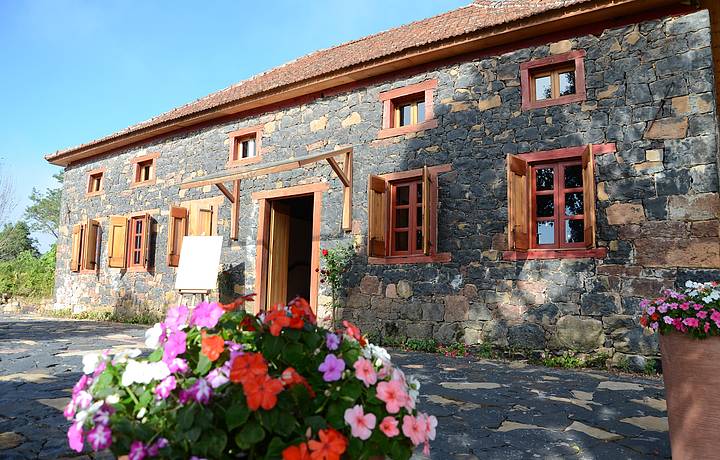
Caravaggio in Farroupilha: When Baroque Meets the Gaucho Hills
Picture this: you’re strolling through the lush landscapes of Farroupilha, southern Brazil, sipping on some fine local wine, when suddenly—BAM! A dramatic beam of light cuts through the darkness and reveals a scene so intense, so theatrical, it feels like you’ve just stepped into the 1600s. No time travel involved, my friend—you’ve just encountered Caravaggio.
Yes, ladies and gentlemen, the master of chiaroscuro, the bad boy of Baroque painting, has landed in Farroupilha. Not in the flesh, of course—Michelangelo Merisi da Caravaggio is still resting in peace (or causing chaos in the afterlife, who knows). But his art and dramatic flair are alive and well in a stunning exhibition that brings his world to the hills of Rio Grande do Sul.
Who was Caravaggio (for those who skipped Art History)?
Caravaggio was the original rockstar of the Baroque era, before rock was even a thing. His paintings were bold, emotional, raw—and his personal life? Let’s just say it wouldn’t look out of place in a Netflix docuseries. He revolutionized painting by casting real people in religious scenes, using dramatic lighting, and focusing on intense, human emotion.
His themes? Sure, they were religious. But not in the “choirs-of-angels” kind of way. His saints looked like exhausted commuters on a Monday morning, and his martyrs bled like soap opera stars.
What’s Caravaggio doing in Farroupilha?
This charming city in southern Brazil, famous for its wine, grapes, and European vibes, decided to up its cultural game with an interactive, sensory-rich exhibition worthy of a Baroque-style selfie. The exhibit features reproductions of iconic works like Supper at Emmaus, Judith Beheading Holofernes, and Saint Jerome, all enhanced with immersive sound, dramatic projections, and curation so sharp it could slice through the darkness in a Caravaggio painting.
Visitors don’t just view the art—they step into it. You’ll feel the tension, notice hidden details in the shadows, and yes, strike your most dramatic pose under theatrical lighting.
Why You Should Go (even if you’re more TikTok than Baroque)
- Immersive experience: You don’t just see the paintings—you live them. It’s like VR with better taste.
- Culture meets wine: A combo more iconic than Romeo and Juliet (with a much happier ending).
- Instagram-worthy: If Caravaggio were alive today, his grid would be flawless. Now, so can yours.
- Modern reflection: The themes—humanity, pain, faith, redemption—are as relevant now as ever.
Conclusion:
Caravaggio in Farroupilha isn’t just an exhibit—it’s a meeting of centuries, styles, and cultures. It’s proof that art doesn’t have to be dusty and distant. It can live right here in the hills, between a glass of wine and a shaft of dramatic light worthy of Hollywood.
So unleash your inner Baroque soul, strike a pose, and dive into the shadows and light of one of history’s most dramatic artists. A little artistic drama never hurt anyone—except maybe Holofernes.
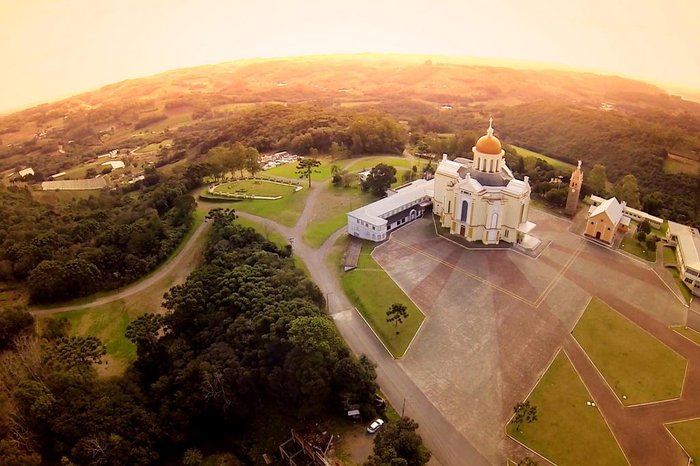
Immigrant Road and Casas Bonnet: A Journey Through the History of Caxias do Sul
Caxias do Sul, a city located in the heart of Brazil’s Serra Gaúcha, is rich in history and culture, especially due to the influence of Italian immigrants who colonized the region in the late 19th century. For those wanting to explore this heritage and admire the city’s natural beauty, the Immigrant Road (Estrada do Imigrante) and the Casas Bonnet are must-see destinations. Let’s dive into this journey filled with tradition, breathtaking landscapes, and authentic local cuisine.
Immigrant Road: A Route Through History and Nature
The Immigrant Road runs through the area known as the Third Legua (Terceira Légua), a historic region tied to the early days of Italian immigration in Caxias do Sul. Along the paved route, visitors are treated to scenic rural landscapes with vineyards, grapevines, and historic buildings that stand as symbols of colonization.
One of the main highlights along the road is the Nossa Senhora de Lourdes Grotto, also known as the Third Legua Grotto. Accessible by a staircase of 150 steps, the grotto is nestled among natural stone walls and adorned with a beautiful waterfall, making it a peaceful and picturesque spot for contemplation.
Another important landmark is the National Monument to the Immigrant, located at the entrance of the city. This bronze monument pays tribute to all the immigrant communities that helped build Brazil. It features a farming couple with a child in the woman’s arms—an emotional symbol of hope, resilience, and hard work.
Casas Bonnet: Tradition and Gastronomy
The Casas Bonnet are among the oldest structures in the region, built between 1877 and 1879. Originally owned by a French family, these stone houses served as inns and dining spaces for newly arrived immigrants. They were also gathering places for traditional community events like weddings, parties, and local “filós” (evenings of music, food, and storytelling).
Today, under the care of the Tonietto Family, the Casas Bonnet have been restored and transformed into a restaurant and museum that celebrate Italian colonial culture. The museum features historical artifacts and tells the story of the early settlers, while the restaurant offers a delicious traditional colonial Italian menu, with recipes passed down through generations.
One of the most charming experiences is the wagon ride, where visitors get a chance to travel through the countryside just like the immigrants once did—connecting with history in a unique and interactive way.
Wine Tourism: Tasting Local Flavors
The Immigrant Road is also a hotspot for wine tourism. The region is home to several family-run wineries producing excellent wines, juices, and sparkling beverages. Many of these wineries are open to visitors for tastings and tours, offering a firsthand look at the production process and the deep-rooted winemaking traditions of the area.
These stops are perfect for those who want to enjoy local flavors, learn more about the culture of grape-growing, and appreciate the craftsmanship of small producers.
A Journey Through Time
As you travel along the Immigrant Road, you’re not just seeing the landscape—you’re walking through a living museum. The road is lined with stone and wooden churches, antique homes, and beautiful surroundings that reflect the rich Italian heritage of the region.
It’s a great route for a bike ride, thanks to the peaceful roads and beautiful views. You can also explore trails and take in the sights, smells, and sounds of rural life, experiencing both nature and culture in one go.
Conclusion: A Must-Do Experience
The Immigrant Road and Casas Bonnet offer a true time-travel experience, allowing visitors to connect deeply with the stories, culture, and traditions of the immigrants who shaped Caxias do Sul. With its stunning landscapes, warm hospitality, and delicious food, this route is a blend of natural beauty, historical heritage, and authentic cultural immersion.
If you’re looking for a genuine and enriching way to experience Caxias do Sul, be sure to visit the Immigrant Road and the Casas Bonnet. It’s a journey that will leave lasting impressions on both your mind and heart.
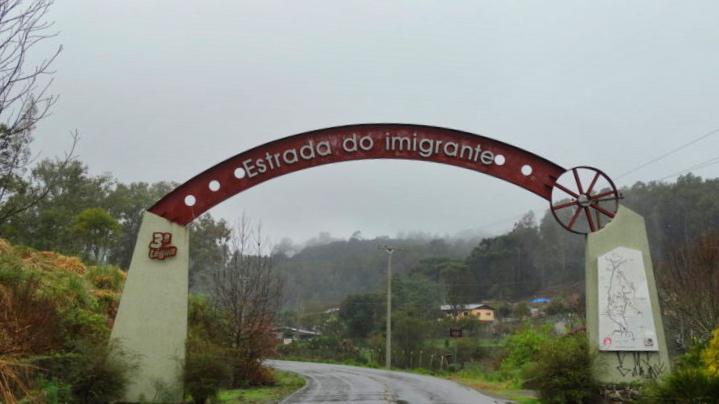
Hércules Galló Institute: History, Culture, and Heritage in Galópolis – Caxias do Sul
Located in the charming neighborhood of Galópolis in Caxias do Sul, Hércules Galló Institute is much more than a museum – it is a space of memory, culture, and identity. Preserving the history of the textile industry and Italian immigration in the region, the institute has become a reference point for anyone looking to understand the past and appreciate the present of one of the most traditional communities in Serra Gaúcha.
Who Was Hércules Galló?
Hércules Galló was born in 1869 in Valle Mosso, Italy. He immigrated to Brazil in the late 19th century, gaining experience in the textile sector in both his home country and in Brazil. In 1904, he settled in Caxias do Sul, where he acquired and reorganized a wool fabric factory, driving the industrial development of Galópolis.
With entrepreneurial vision and a strong sense of community, Galló played a key role in the growth of Galópolis, fostering employment, education, and culture. He passed away in 1921, but his legacy continues to resonate in the streets and memories of the local people.
Hércules Galló Institute: A Living Museum
Founded by his descendants, the institute’s mission is to preserve the history of Hércules Galló and the community that grew around the textile industry. The institute is housed in two historic wooden houses built between 1904 and 1908, which have been carefully restored and transformed into exhibition areas.
In addition to the historic houses, the complex includes a modern building that hosts events, workshops, and cultural activities. The institute is also home to initiatives like the Galópolis Territory Museum, a circuit of 15 historical points spread throughout the neighborhood, creating a true open-air museum experience.
What to Expect During Your Visit
The Institute offers a complete immersion into local history with various experiences for visitors:
- Permanent and Temporary Exhibitions
The 12 museum rooms showcase a rich and well-preserved collection of objects, furniture, clothing, documents, and utensils from the period. The aim is to present the daily life of the Galló family and the life of workers connected to the textile industry. - Heritage Education Workshops
These free workshops are open to the public and designed for schools, groups, and families. They aim to encourage the care and appreciation of local memory, culture, and heritage. - Galópolis Territory Museum
By appointment, you can explore the 15 historical points scattered across the neighborhood, including former factories, workers’ houses, schools, churches, and squares. A true outdoor history lesson.
Useful Information
- 📍 Address: BR-116, No. 1579 – Galópolis Neighborhood, Caxias do Sul – RS
- 🕒 Opening Hours: Tuesday to Saturday, from 1:30 PM to 5:30 PM
- 🎟 Admission: Free
- 📞 Contact/WhatsApp: (54) 9 9166-7706
- 🌐 Website: www.herculesgallo.com.br
- 📸 Instagram: @institutoherculesgallo
Why Visit Hércules Galló Institute?
If you value history, culture, and want to deeply understand how communities like Galópolis contributed to Brazil’s development, this visit is a must. The Institute combines memory, preserved architecture, and education in an engaging way.
It is an ideal program for families, students, historians, and anyone who simply enjoys a well-told story. And the best part: all of this is offered with free admission in a welcoming environment, surrounded by the natural beauty of Serra Gaúcha.

Monte Sant’Ana Winery: Tradition, Quality, and Hospitality in São Marcos – RS
Nestled among the valleys and hills of the charming town of São Marcos, in Brazil’s Serra Gaúcha, Monte Sant’Ana Winery is a true haven for wine lovers and those seeking authentic experiences. With its own vineyards, an artisanal philosophy, and stunning surroundings, the winery represents a new generation of producers who blend family tradition with innovation and excellence.
A Story Rooted in Passion for Wine
Monte Sant’Ana’s journey began in 2001, when the founders acquired a beautiful property in Linha Santana, a rural area of São Marcos. Their passion for viticulture and the dream of producing wines with personality led to the official founding of the winery in 2010 by Jandir Panassol, Andrea Soldatelli Panassol, and Tânia Soldatelli.
In 2012, the first vineyards were planted with Moscato Giallo, Merlot, and Ancellotta—the varieties that now serve as the foundation for the winery’s elegant and expressive labels. Since then, each vintage has been crafted with care, respecting nature’s rhythm and honoring the unique terroir of São Marcos.
Artisan Quality with a Sustainable Touch
Monte Sant’Ana embraces sustainable practices throughout its entire process, from vine to bottle. The result is a lineup of wines that are authentic, balanced, and rich in character. More than just creating high-quality wines, the winery tells a story in each bottle—one of land, family, and attention to every detail.
Their philosophy values manual labor and direct connection with customers, reinforcing a genuine relationship between those who make and those who enjoy the wine.
Wine Tourism: A Personal and Memorable Experience
For visitors looking for more than just a wine tasting, Monte Sant’Ana offers customized wine tourism experiences, which include:
- Guided tour of the vineyards and production areas
- Wine tasting sessions paired with local flavors
- Family stories and insights into the terroir of São Marcos
- A cozy and exclusive setting (by appointment only)
Visiting the winery feels like being welcomed into a family home. It’s a peaceful, authentic experience surrounded by the natural beauty of Serra Gaúcha—a place where wine is truly lived.
Location and Contact
📍 Address: Linha Santana, rural area – São Marcos/RS
📞 Phone/WhatsApp: +55 (54) 9 9973-9896
🌐 Website: www.montesantana.com.br
📸 Instagram: @monte_santana
Why Visit Monte Sant’Ana Winery?
Monte Sant’Ana is more than a winery—it’s a place where wine is crafted with soul, tradition, and care. Whether you’re a seasoned wine connoisseur or someone who simply enjoys a good glass, a visit to this family-run winery is an unforgettable journey into the heart of Brazilian wine culture.
Among the vineyards of São Marcos, you’ll discover authentic flavors, breathtaking landscapes, and people who make wine with genuine passion. It’s a destination that delights the senses and nourishes the spirit.
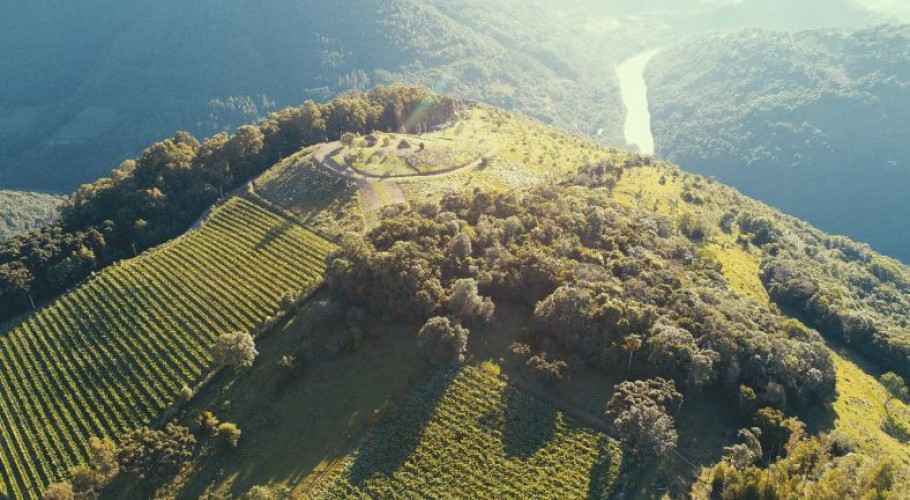
Vera Tormenta Waterfalls Park: Nature and Leisure in Vacaria, Brazil
Located in the 5th District of Vacaria, in the heart of Brazil’s Serra Gaúcha, the Vera Tormenta Waterfalls Park is the perfect destination for nature lovers, ecotourism enthusiasts, and families looking for a mix of adventure and relaxation. With three stunning waterfalls, eco-trails, camping areas, and rustic cabins, the park offers an unforgettable experience surrounded by lush natural beauty.
History and Origins
The park first opened its doors to the public on October 10, 1996, thanks to the initiative of plastic artist Vera Tormenta Goulart and her family. From the beginning, their vision was to promote sustainable tourism while preserving the natural environment. The park quickly became a popular attraction in the region, offering scenic beauty and environmental awareness in one immersive experience.
Main Attractions
The highlight of the park is its three waterfalls located along the Quebra-dentes River. Set about 150 meters apart from each other, each waterfall has its own charm:
- First Waterfall: Approximately 5 meters high and 40 meters wide, this one is the most accessible. It features a wide rocky surface above—great for children—and a natural pool at the bottom, ideal for swimming and relaxing.
- Second Waterfall: More impressive in size, it’s around 90 meters wide with natural rapids and large boulders. It also has a deep natural pool, making it perfect for those seeking a refreshing and adventurous swim.
- Third Waterfall: The most secluded of the three, this waterfall is about 25 meters tall and 50 meters wide. It can be viewed from scenic overlooks reached by hiking trails, offering a breathtaking view of both the falls and the surrounding forest.
In addition to the waterfalls, the park features eco-trails where visitors can explore the region’s rich biodiversity. Each trail provides direct contact with native flora and fauna, allowing guests to fully experience the magic of the Atlantic Forest.
Facilities and Services
Vera Tormenta Waterfalls Park offers a complete infrastructure for visitors to enjoy nature with comfort and convenience:
- Rustic Cabins: The park has 8 cozy cabins, each equipped with a sink, bathroom, barbecue grill, table, benches, and mattresses—ideal for those looking to stay overnight in nature with added privacy.
- Picnic and Barbecue Shelters: There are 5 shelters with grills, sinks, tables, and benches—great for group meals or casual outdoor relaxation.
- Camping Area: For those who prefer a closer connection with nature, the park offers 4 designated camping spots equipped with tents, allowing for a more rustic overnight experience.
- On-site Store: Visitors can purchase ice, charcoal, water, sodas, snacks, beer, and popsicles on-site—ensuring convenience during their stay.
Additional Information
- 📍 Location: Estrada Vera Tormenta, Vacaria, Rio Grande do Sul – Brazil
- 📞 Contact (WhatsApp): +55 (54) 9 9909-8826
- 📅 Reservations: Recommended in advance, especially during peak seasons.
Final Thoughts
Whether you’re planning a day trip or a longer stay, Vera Tormenta Waterfalls Park offers the perfect combination of breathtaking scenery, natural tranquility, and quality infrastructure. With its impressive waterfalls, nature trails, and family-friendly atmosphere, it is a must-visit destination in the countryside of Vacaria.
Come reconnect with nature, relax by the river, and enjoy unforgettable moments in one of the most beautiful ecological parks in southern Brazil.
